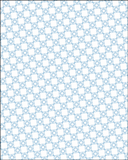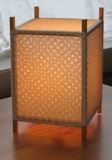Moiré Lace Lamp

Face 1 0° |

Face 2 ~7° |

Face 3 ~13° |

Face 4 ~22° |
|
The pattern for the outer layers was very simple, since it is just roseground; but I had to make four separate patterns for the inner layers. To determine the angles for the three angled inner layers, I printed a line-drawing representation of the roseground on paper and again on a transparency, which I placed over the paper printout and turned until I found three resulting moiré patterns I liked. I then used a paper frame, the size of the finished panel and aligned with the paper printout, to isolate a section of the transparency, which I then pricked to make the pattern. |

Straight Roseground |

Angled Roseground |

Overlapping |
|
Making the actual lace became rather boring—essentially, it was 160 square inches of roseground! I considered working it as Flanders ground, to speed up the work, but since precision is critical to the moiré effect, I decided to use the extra pins. The only slightly challenging bit was the edges of the inner faces, since the roseground joined the borders at peculiar angles. Maintaining the precision of the stitches required some creativity.
I worked the lace in a very pale pink Madeira Tanne 30. The inner panels are backed with tightly-woven lightweight cotton fabric to diffuse the light. I constructed the frame using ¼ in. x ¼ in. square dowels. The lamp has a 40 watt bulb.
While I am pleased with the results (I especially like the way the patterns "move" as one walks around the lamp), I probably won't make another like this; I prefer patterns with more variety in the working. I have thought about making a single pair of panels with a motif surrounded by ground in the outer layer, using the moiré for effect around it. But so far I've not wanted to tackle that much plain ground again. |
 |
 |
 |
| The lamp looks different in different lighting conditions. | ||
